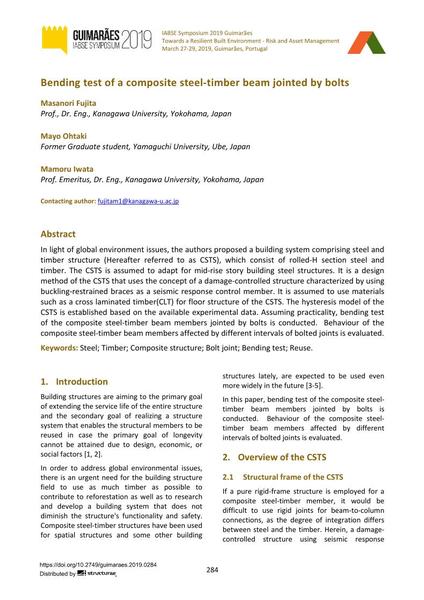Bending test of a composite steel-timber beam jointed by bolts

|
|
|||||||||||
Bibliographic Details
| Author(s): |
Masanori Fujita
(Prof., Dr. Eng., Kanagawa University, Yokohama, Japan)
Mayo Ohtaki (Former Graduate student, Yamaguchi University, Ube, Japan) Mamoru Iwata (Prof. Emeritus, Dr. Eng., Kanagawa University, Yokohama, Japan) |
||||
|---|---|---|---|---|---|
| Medium: | conference paper | ||||
| Language(s): | English | ||||
| Conference: | IABSE Symposium: Towards a Resilient Built Environment Risk and Asset Management, Guimarães, Portugal, 27-29 March 2019 | ||||
| Published in: | IABSE Symposium Guimarães 2019 | ||||
|
|||||
| Page(s): | 284-289 | ||||
| Total no. of pages: | 6 | ||||
| DOI: | 10.2749/guimaraes.2019.0284 | ||||
| Abstract: |
In light of global environment issues, the authors proposed a building system comprising steel and timber structure (Hereafter referred to as CSTS), which consist of rolled-H section steel and timber. The CSTS is assumed to adapt for mid-rise story building steel structures. It is a design method of the CSTS that uses the concept of a damage-controlled structure characterized by using buckling-restrained braces as a seismic response control member. It is assumed to use materials such as a cross laminated timber(CLT) for floor structure of the CSTS. The hysteresis model of the CSTS is established based on the available experimental data. Assuming practicality, bending test of the composite steel-timber beam members jointed by bolts is conducted. Behaviour of the composite steel-timber beam members affected by different intervals of bolted joints is evaluated. |
||||
| Keywords: |
steel composite structure timber bending test reuse Bolt joint
|
||||
